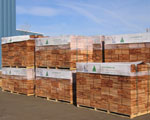Alaskan Yellow Cedar Shingles

Other common names: Nootka cypress, sitka cypress, pacific yellow cedar. Found only on the Pacific coast of North America, Yellow Cedar is the hardest known cedar in the world. Prized by boat builders, it has exceptional resistance to weather and insects as well as easy workability. First used by the West Coast Indians for their historic Totem Poles and great war canoes, it is a rare and often difficult to find lumber species.
Its durability and ease of tooling makes it readily adaptable for the construction and finishing of homes, schools, factories, churches, recreational centers and a variety of commercial and industrial uses. It grows in a band from Southern Alaska to Southern Oregon. It is one of the slowest growing trees in North America and includes trees that are 700-1200 years old. 50-60 annual rings per inch are not uncommon. This rare and exceptionally beautiful wood species seeks out high and adventurous sites and often grows to the tree line. It is a medium sized tree, with a thin bark. It is slow growing with high disease and decay resistance, as well as oils that make it very aromatic. It grows from Alaska south to Oregon with the largest areas of growth in British Columbia and SE Alaska.
Alaskan Yellow Cedar has exceptional decay resistance combined with a fine texture, strength and straight grain. Its consistent yellow color gives it a characteristic unlike most other species, but the most outstanding characteristic of Yellow Cedar is its natural ability to weather uniformly to a consistent silvery grey on sidewalls and roofs, a characteristic that is highly sought after by discerning homeowners and architects.
Yellow cedar is a timber of the Pacific coast region of North America from Alaska to southern Oregon. It comes from a tree of modest size in comparison with others in these forrests, reaching 30m in height, with a trunk up to 1m in diameter. Found only on the Pacific coast of North America, Yellow Cedar is the hardest known cedar in the world. Only a limited amount of this wood is available every year. Yellow cedar is pale yellow and a little darker than Port Orford cedar and a little heavier than spruce. Prized by boat builders, it has exceptional resistance to weather and insects as well as easy workability. Yellow cedar dries well with little shrinkage, and once dry is noted for its stability in use. It is a moderately strong wood, stiff for its weight and with good shock resistance. It works easily and takes a good finish with both hand and machine tools. Like Port Orford cedar it is noted for its resistance to decay. Yellow cedar is an attractive, valuable but not very abundant wood, shipped in small quantities, mainly from British Columbia. It has many of the characteristics of Port Orford cedar and is used for similar purposes, in boat-building and for joinery and for furniture. It is an excellent wood for use out of doors; among its more specialized are engineers’ patterns, surveyors’ poles and it has always been considered one of the best woods for battery separators.
